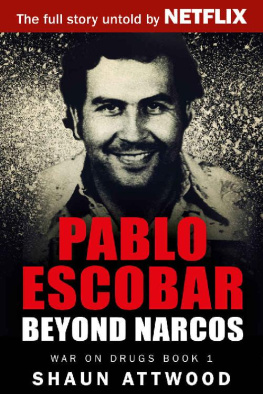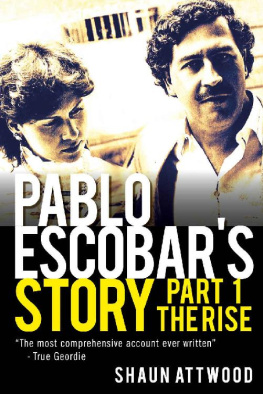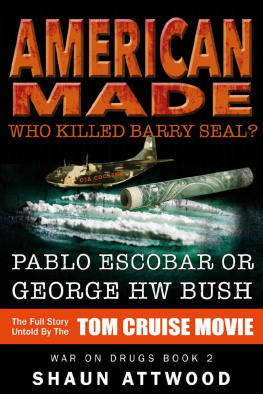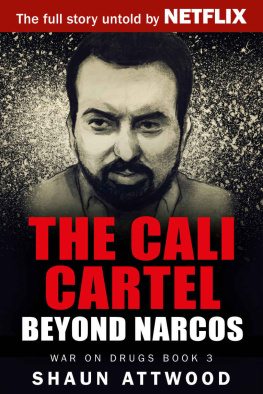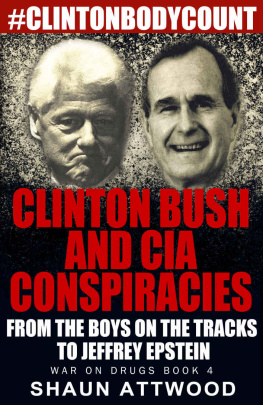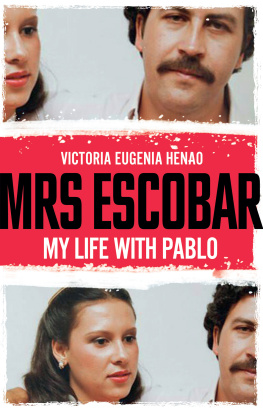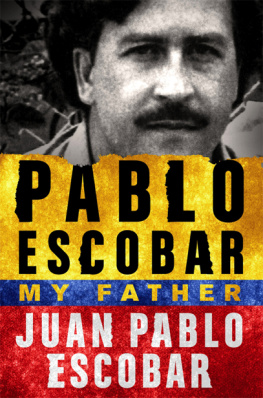Pablo Escobar:
Beyond Narcos
Shaun Attwood
First published in Great Britain by Gadfly Press (Shaun Attwood) in 2016
Copyright Shaun Attwood 2016
The right of Shaun Attwood to be identified as the author of this work has been asserted by him in accordance with the Copyright, Designs and Patents Act 1988. All rights reserved
No part of this book may be reproduced, stored in a retrieval system or transmitted in any form or by any means (electronic, mechanical, photocopying, recording or otherwise) without the prior written permission of the author, except in cases of brief quotations embodied in reviews or articles. It may not be edited, amended, lent, resold, hired out, distributed or otherwise circulated without the publishers written permission
Permission can be obtained from
This book is a work of non-fiction based on research by the author
A catalogue record of this book is available from the British Library
ISBN: 978-0-9930215-2-7
Typeset and cover design by Jane Dixon-Smith
For Zivi
Get A Free Book
Sign Up For My Newsletter
Sign Up Page
My Social-Media Links
Email:
Blog: Jons Jail Journal
Website: shaunattwood.com
Twitter: @shaunattwood
YouTube: Shaun Attwood
LinkedIn: Shaun Attwood
Goodreads: Shaun Attwood
Facebook pages: Shaun Attwood , Jons Jail Journal , T-Bone Appreciation Society
I welcome feedback on any of my books.
Thank you for the Amazon reviews!
Acknowledgements
A big thank you to Barbara Attwood, Derick Attwood, Penny Kimber, Emma Bagnell, Jane Dixon-Smith
My Books
English Shaun Trilogy
Party Time
Hard Time
Prison Time
War on Drugs Trilogy
Pablo Escobar: Beyond Narcos
American Made: Who Killed Barry Seal? Pablo Escobar or George HW Bush
We Are Being Lied To: The War on Drugs (Expected 2017)
Life Lessons
Making a Murderer: The Framing of Avery and Dassey by Kratz and Other Parasites (Expected 2017)
Two Tonys (Expected 2017)
T-Bone (Expected 2020)
Contents
Chapter 1
Early Years
Pablo Escobar was born on a cattle ranch in 1949, the second year of The Violence, a civil war that saw millions of Colombians flee their homes and left hundreds of thousands dead. Slicing people up with machetes was popular and led to a new genre of slaughter methods with ornate names. The Flower Vase Cut began with the severing of the head, arms and legs. The liberated limbs were stuffed down the neck, turning the headless torso into a vase of body parts. A victim stabbed in the neck, who had his tongue pulled out through the gap and hung down his chest was wearing a Colombian Necktie. The turmoil affected nearly every family in Colombia. It accustomed Pablos generation to extreme violence and the expectancy of a short and brutal life.
Pablos parents were Abel de Jess Dari Escobar, a hard-working peasant farmer who traded cows and horses, and Hermilda Gaviria, an elementary-school teacher. As her husband was mostly absent due to work, Hermilda cooked, cleaned and took care of her family. Pablo was the third of seven children.
One day, tiny Pablo wandered away from home. Hermilda found him under a tree, with a stick, playing with a snake.
See, Im not hurting you, Pablo said to the snake.
Gazing affectionately, Hermilda knew that Pablo was a sweet boy who loved animals.
The nearest school was so far away that Pablo and his brother, Roberto, had to wake up early. With no means of transportation, it took them an hour to walk there in worn-out shoes.
Rather that wear shoes with holes in them, Pablo decided to go to school barefooted. His teacher sent him home. Humiliated, Pablo told his mother that he needed new shoes to stay in school. As she had no money, she deliberated her options and shoplifted a pair of shoes. At home, she noticed that each shoe was a different size. Disheartened, she confessed to a priest, who advised her to return the shoes and get them on credit.
She bought the shoes and arrived home, exhausted and anxious. With such a large family to feed, she complained about their lack of money.
Dont worry, mom, Pablo said. Wait until I grow up. Ill give you everything.
As The Violence between the Conservative and Liberal parties escalated, the family was warned to leave or else risk having their body parts re-assembled into art. But having no safe place to go, and loving the animals, the beautiful countryside adorned with wildflowers, and air that carried a taste of pine and resin from the forest, they chose to stay.
Pablo was seven when the guerrillas entered his village near the town of Rionegro, the Black River. Trembling, he heard machetes hacking the front door and threats of murder. He clung to his mother, who was crying and praying. His father said they would be killed, but at least they could try to save the kids. They hid the kids under mattresses and blankets.
The front door was so strong that the guerrillas eventually gave up trying to break in. Instead, they set fire to it. Wincing and coughing in a house filling with smoke, Pablos parents braced to die. But soldiers arrived and the guerrillas fled.
With a burning building illuminating the street, the towns survivors were escorted to a schoolhouse. Pablo would never forget the charred bodies and the corpses hanging from the lampposts. Internalized in the terrified child, the horrors of The Violence would re-emerge years later, when he kidnapped, murdered and bombed to maintain his empire.
Growing up with six siblings, Pablo bonded the most with Roberto, who was two years his senior. Roberto was intelligent and had a passion for mathematics, electronics and cycling. Pablo enjoyed watching Roberto construct things such as radios, but rather than join in, he sat around for most of the day as if lost in thought.
Pablo and Roberto were sent from the familys ranch to live with their grandmother in the safety of Medelln, known as the City of the Eternal Spring due to a steady climate averaging around 22.2C or 72F. Downtown was a cluster of glass and steel skyscrapers separated by roads lined with trees. The surrounding expanse of houses grew more dilapidated towards the shantytowns, slums and garbage dumps places crammed with displaced people where gangs of street kids, thieves and pickpockets roamed. The tough residents of Medelln worked hard to get ahead.
Pablos grandmother was an astute businesswoman who bottled sauces and spices and sold them to supermarkets. Under her loving but stern hand, Pablo and Roberto had to go to church and pray every morning.
Although they loved the weather and the mountainous landscape, the second largest city in Colombia with all of its fast cars and over a million people intimidated the brothers, who were accustomed to the tempo of ranch life. They were delighted when their parents joined them, but their father disliked living in the city, so he returned to the countryside to work on other peoples farms. Eventually, the brothers fell in love with Medelln.
The atmosphere at home was heavily religious. They had a figurehead of Jesus with realistic blood. After his mother told him Christs story, young Pablo was so sad that when lunch was served, he put a piece of meat in his corn cake and took it to the figurehead. Poor man, who made you bleed? Do you want a little meat? This act convinced his mother that he was kind and religious. For the rest of his life, Pablo would always try to sleep with an image of Jesus nearby.
Hermilda enchanted Pablo with stories about his grandfather, Roberto Gaviria, who had smuggled whiskey. With long-range planning and a creative imagination, Roberto the bootlegger had outsmarted everyone, including the authorities. Pablo wanted to emulate his grandfathers success.
Growing up in a suburb of Medelln called Envigado, the kids built carts from wood and raced down hills. They made soccer balls from old clothes wrapped inside of plastic bags, erected makeshift goalposts and played with the other kids in the neighbourhood. It was Pablos favourite sport. A popular prank was to stick chewing gum on a doorbell, so that it rang continuously.
Next page
